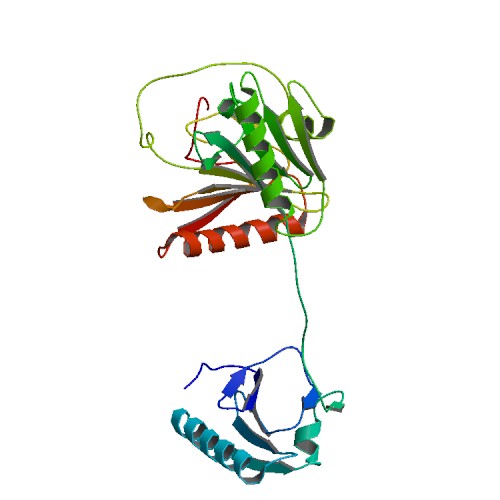CAPG
 From Wikidoc - Reading time: 4 min
From Wikidoc - Reading time: 4 min
| Capping protein (actin filament), gelsolin-like | |||||||||||||
|---|---|---|---|---|---|---|---|---|---|---|---|---|---|
 PDB rendering based on 1j72. | |||||||||||||
| |||||||||||||
| Identifiers | |||||||||||||
| Symbols | CAPG ; AFCP; MCP | ||||||||||||
| External IDs | Template:OMIM5 Template:MGI HomoloGene: 37523 | ||||||||||||
| |||||||||||||
| RNA expression pattern | |||||||||||||
 | |||||||||||||
| More reference expression data | |||||||||||||
| Orthologs | |||||||||||||
| Template:GNF Ortholog box | |||||||||||||
| Species | Human | Mouse | |||||||||||
| Entrez | n/a | n/a | |||||||||||
| Ensembl | n/a | n/a | |||||||||||
| UniProt | n/a | n/a | |||||||||||
| RefSeq (mRNA) | n/a | n/a | |||||||||||
| RefSeq (protein) | n/a | n/a | |||||||||||
| Location (UCSC) | n/a | n/a | |||||||||||
| PubMed search | n/a | n/a | |||||||||||
Capping protein (actin filament), gelsolin-like, also known as CAPG, is a human gene.[1]
This gene encodes a member of the gelsolin/villin family of actin-regulatory proteins. The encoded protein reversibly blocks the barbed ends of F-actin filaments in a Ca2+ and phosphoinositide-regulated manner, but does not sever preformed actin filaments. By capping the barbed ends of actin filaments, the encoded protein contributes to the control of actin-based motility in non-muscle cells. Alternatively spliced transcript variants have been observed, but have not been fully described.[1]
References[edit | edit source]
Further reading[edit | edit source]
- Dabiri GA, Young CL, Rosenbloom J, Southwick FS (1992). "Molecular cloning of human macrophage capping protein cDNA. A unique member of the gelsolin/villin family expressed primarily in macrophages". J. Biol. Chem. 267 (23): 16545–52. PMID 1322908.
- Southwick FS (1995). "Gain-of-function mutations conferring actin-severing activity to human macrophage cap G.". J. Biol. Chem. 270 (1): 45–8. PMID 7814409.
- Mishra VS, Henske EP, Kwiatkowski DJ, Southwick FS (1995). "The human actin-regulatory protein cap G: gene structure and chromosome location". Genomics. 23 (3): 560–5. doi:10.1006/geno.1994.1543. PMID 7851883.
- Maruyama K, Sugano S (1994). "Oligo-capping: a simple method to replace the cap structure of eukaryotic mRNAs with oligoribonucleotides". Gene. 138 (1–2): 171–4. PMID 8125298.
- Hirano T, Kobayashi R, Hirano M (1997). "Condensins, chromosome condensation protein complexes containing XCAP-C, XCAP-E and a Xenopus homolog of the Drosophila Barren protein". Cell. 89 (4): 511–21. PMID 9160743.
- Suzuki Y, Yoshitomo-Nakagawa K, Maruyama K; et al. (1997). "Construction and characterization of a full length-enriched and a 5'-end-enriched cDNA library". Gene. 200 (1–2): 149–56. PMID 9373149.
- Cabello OA, Eliseeva E, He WG; et al. (2002). "Cell cycle-dependent expression and nucleolar localization of hCAP-H". Mol. Biol. Cell. 12 (11): 3527–37. PMID 11694586.
- Strausberg RL, Feingold EA, Grouse LH; et al. (2003). "Generation and initial analysis of more than 15,000 full-length human and mouse cDNA sequences". Proc. Natl. Acad. Sci. U.S.A. 99 (26): 16899–903. doi:10.1073/pnas.242603899. PMID 12477932.
- Van Impe K, De Corte V, Eichinger L; et al. (2003). "The Nucleo-cytoplasmic actin-binding protein CapG lacks a nuclear export sequence present in structurally related proteins". J. Biol. Chem. 278 (20): 17945–52. doi:10.1074/jbc.M209946200. PMID 12637565.
- Pellieux C, Desgeorges A, Pigeon CH; et al. (2003). "Cap G, a gelsolin family protein modulating protective effects of unidirectional shear stress". J. Biol. Chem. 278 (31): 29136–44. doi:10.1074/jbc.M300598200. PMID 12754261.
- De Corte V, Van Impe K, Bruyneel E; et al. (2005). "Increased importin-beta-dependent nuclear import of the actin modulating protein CapG promotes cell invasion". J. Cell. Sci. 117 (Pt 22): 5283–92. doi:10.1242/jcs.01410. PMID 15454578.
- Gerhard DS, Wagner L, Feingold EA; et al. (2004). "The status, quality, and expansion of the NIH full-length cDNA project: the Mammalian Gene Collection (MGC)". Genome Res. 14 (10B): 2121–7. doi:10.1101/gr.2596504. PMID 15489334.
- Watari A, Takaki K, Higashiyama S; et al. (2007). "Suppression of tumorigenicity, but not anchorage independence, of human cancer cells by new candidate tumor suppressor gene CapG". Oncogene. 25 (56): 7373–80. doi:10.1038/sj.onc.1209732. PMID 16767159.
- Chi A, Valencia JC, Hu ZZ; et al. (2007). "Proteomic and bioinformatic characterization of the biogenesis and function of melanosomes". J. Proteome Res. 5 (11): 3135–44. doi:10.1021/pr060363j. PMID 17081065.
| This protein-related article is a stub. You can help Wikipedia by expanding it. |
Licensed under CC BY-SA 3.0 | Source: https://www.wikidoc.org/index.php/CAPG105 views | Status: cached on September 26 2025 15:08:12↧ Download this article as ZWI file
 KSF
KSF